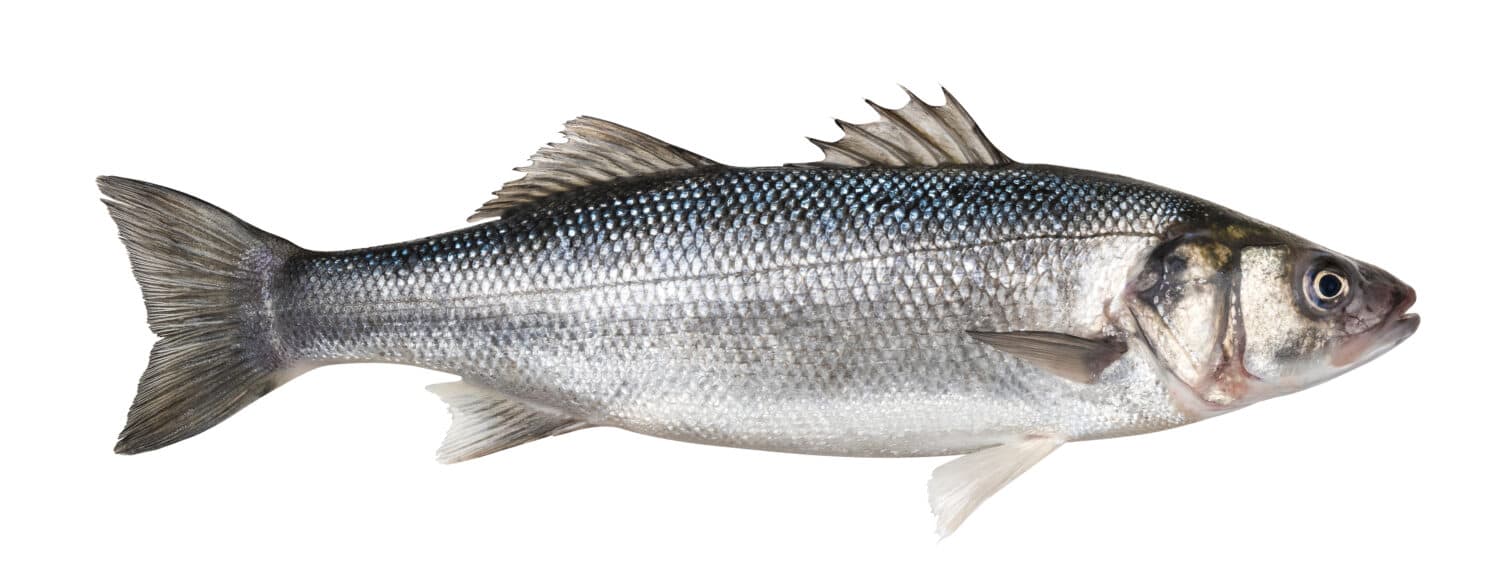White sea bass are tricky to catch and can take some finesse reeling one in. But they are prized among fishermen for their mild flavor and thick, meaty texture. You can get some good fillets from a white sea bass, which hold together well for grilling, frying, and baking. It’s a popular fish for Californians, and while these fish will grow substantially, the largest white sea bass ever caught in California is impressive.
Description of White Sea Bass

White Sea Bass are a brilliant silver color and flash white as they swim through the water in large schools.
©Spalnic/Shutterstock.com
This fish has many names, including white weakfish, seatrout, king croaker, and others. The white sea bass is the largest member of the croaker family, despite having the name sea bass. It belongs to a large order of perch-like fish. White sea bass have bluish-gray upper bodies dotted with dark speckling with flashy, silvery bellies. When white sea bass are young, they also sport dark vertical bars and countershading along their sides for camouflaging.
Elongated in shape, white sea bass have big mouths with a slightly larger lower jaw. Because of their soft mouths, they can be tough to reel in. With a row of tiny sharp teeth, most fishermen opt for a heavier line to keep the white sea bass from biting off.
White sea bass typically live 12 to 20 years old.
Typical White Sea Bass Size
While white sea bass may start off small, they don’t stay that way. On average, a white sea bass that is one year old weighs about six ounces and is five inches in length. However, by age five, a white sea bass is around 7.5 to eight pounds and 28 inches long. And, by 15 years of age, it’s a whopping 37 to 38 pounds and 49 inches long.
It’s no wonder that the white sea bass is the largest member of the croaker family. White sea bass weighing over 90 pounds have been recorded in California, though most don’t reach over 60 pounds. The average length of an adult white sea bass is between 24 and 60 inches.
Diet
White sea bass are commonly secondary and tertiary predators. That means on the food chain, there are primary producers, which primary consumers eat. The primary consumers are ingested by secondary predators, and tertiary predators devour the secondaries, and so on.
White sea bass target smaller fish like anchovies, sardines, and mackerel. Depending on availability, they will also eat squids, crustaceans, and other marine invertebrates. But, when white sea bass are juveniles, they primarily survive on mysid shrimp.
The main predators the white sea bass has to fear are sharks, sea lions, and fishermen. However, their camouflage coloration and countershading help keep them hidden, and schooling together helps their survival.
Habitat

When the small white sea bass fries are a couple of years old, they seek out shallow coastal waters with seaweed or eelgrass for protection from predators.
©inusuke/iStock via Getty Images
Keeping to the eastern Pacific coastline, these fish may be found from Baja California, Mexico, all the way up to Juneau, Alaska. White sea bass also inhabit the Gulf of California. They need saltwater and brackish water to survive and congregate along rocky or soft bottoms. White sea bass prefer deep water, and chances are you will find them up to a depth of 400 feet.
When they are first hatched, white sea bass dwell in shallow coastal waters or hide among the seaweed. But after they are a few years old, they will relocate to bays with plenty of cover, such as eelgrass beds, kelp beds, or piers.
The white sea bass population steadily declined because of overfishing, pollution, and shrinking habitats. But because of California’s hatcheries and new fishing regulations, the white sea bass population has bounced back.
Reproduction
White sea bass mate up to six times a year. In southern California, spawning season occurs between April through August, and females and males will meet near a rocky shoreline or by a kelp bed. White sea bass are broadcast spawners, meaning the female releases up to 1.5 million into the water. Then, one or more males release sperm over the free-floating eggs, fertilizing them.
The eggs develop while they are suspended in the water column. Over the next several months, they will grow into fry, capable of swimming. The little fry will travel to shallow, coastal waters with eelgrass beds for shelter.
The Largest White Sea Bass Ever Caught in California

While most white sea bass grow to around 60 pounds, some have surpassed 90 pounds. However, the largest white sea bass ever caught in California was even bigger than that.
On June 20, 2020, fisherman John T. Rieger caught a giant white sea bass while ocean diving in Santa Barbara. This specimen was 94 pounds and 6 ounces with a length of 63.4 inches. This put Rieger in the book for the largest white sea bass ever caught in California.
Thank you for reading! Have some feedback for us? Contact the AZ Animals editorial team.







